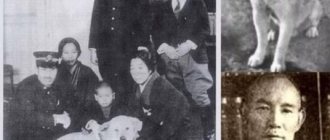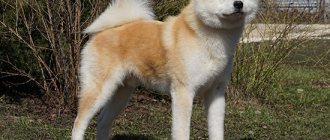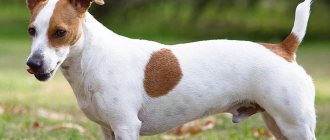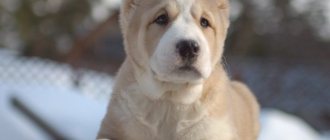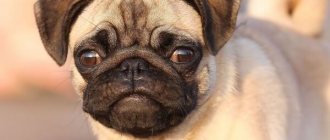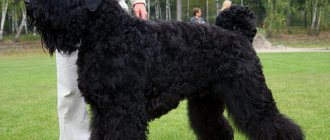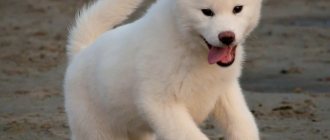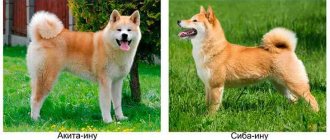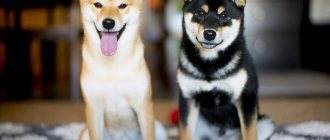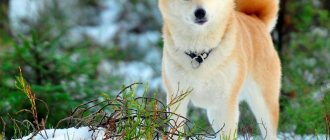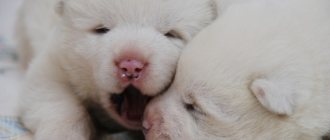The breed of dog from the movie “Hachiko: The Most Faithful Friend” is Akita Inu. The film is based on the true story of the dog Hachiko, a dog who came to the train station every day for ten years and waited for his deceased owner.
The film, starring Richard Gere, brought Hachiko international fame. And the very image of the dog became in Japan an example of selfless love and devotion.
What is the name of the small breed, its history
In fact, it would not be entirely correct to talk about this miniature dog as a mini Akita, since at present it is a separate breed called the Shiba Inu. Like most other traditional Japanese breeds, it got its name from the name of the area in which it was bred.
“Dog from Shiba” - this is how it can be translated literally. However, there are other versions. According to one of them, the Shiba got its name from the word “shibafu”, which can be translated as “tuft of grass” by analogy of the color of this animal with the color of sun-dried grass. also a hypothesis that the name translates as “dog from the bush forest” .
In any case, it should be recognized that the Shiba is a very ancient breed. Dogs similar to her were found on the territory of modern Japan already three thousand years ago. The history of this breed is noteworthy in that mini Akitas were bred to guard monasteries and only later were they adapted for hunting. The monks treasured these dogs and made sure that the puppies did not fall into the hands of ordinary people, even the nobility.
NOTE!
The monks especially valued silence in their dogs, as this helped maintain the silence and atmosphere of serenity so characteristic of Japanese monasteries.
But at the same time, Shiba Inu had to be fast, resilient and have excellent reactions necessary for hunting. For a long time they were bred exclusively in monasteries, but, in the end, these dogs somehow ended up outside their walls and almost immediately became as beloved by local residents as the Akita Inu.
Official breeding of the Shiba in Japan began in 1928, when the Society for the Preservation of Aboriginal Breeds was founded, and these dogs themselves were declared a national treasure. The FCI recognized the Shiba Inu as a breed in 1964. And in Russia, the first representatives of this breed appeared at the very end of the 20th century.
The True Story of Hachiko
The white Akita Inu dog was born in 1923 on the Japanese Akita farm in the northern region of the island of Honshu. About a year later, the owner decided to give the dog as a gift to the professor of agricultural science at Tokyo's Hidesaburo Umno Institute. Professor Ueno admired the beautiful breed of dog from the film Hachiko, the name was invented by Hachiko. Every morning he left for work, and Hachiko followed him and waited for him at the entrance of the nearby Shibuya Station. Sad events occurred on May 21, 1925, when Hachiko was 18 months old. That day the professor had a stroke. He died and never returned to the station where the dog was waiting for him. After the death of Ueno, Hachiko was given to new owners, but he constantly ran away and came to his old place, where he lived with the professor.
When Hachiko realized that the professor was no longer there, he returned back to the station. After this day, every day at 4 o’clock, when the train arrived, he came to the station to meet with the professor. This continued every day, month, year, for the next 10 years. Many passers-by who visited the station every day brought food for the dog. One of the professor’s former students became interested in her, who learned about his incredible story from his new owners. The student was impressed by Hachiko's story and visited the station every time to write articles about this loyal dog and his breed.
In 1933, after an article was written in the Asahi Shimbun, the country's largest newspaper, the dog became an international sensation. Teachers and parents across the country cited the dog's devotion to their children and students as an example. His bronze bust was installed in the front of the station, and Hachiko himself was at the opening ceremony. Alas, during the Second World War the bust was destroyed for military purposes. At the end of the war, the son of the original monument's architect restored the monument in 1948. Hachiko was found dead on March 8, 1935 on Shibuya Street. He died due to heart failure and terminal cancer. Moreover, there were 4 sticks in his stomach waiting for frying chicken kebab, but they were not a consequence of death. After his death, a day of mourning was declared in Japan. Hachiko's remains, stuffed, were installed at the National Science Museum in Tokyo. Today, the dog monument is installed in front of Shibuya Station, waiting and believing that its owner will return home.
Appearance, standard and photo
The Shiba is a relatively small dog with a proportional, harmonious and moderately muscular build . The ratio between height at the withers and body length is 100:110 in males; in females the body format is somewhat more elongated.
The head is of a size commensurate with the body, with a wide skull, a clearly defined transition to a muzzle slightly tapering towards the end. The cheekbones are well defined, and there is a small longitudinal groove on the forehead. The eyes are slightly slanted, small, triangular in shape, their color is one of the shades of dark brown.
The ears are erect, medium-sized, triangular, turned forward. The nose is black. The neck is strong and quite muscular. The back is strong and straight. The stomach is tucked, but not excessively. The tail is set high, curled into a ring on the back.
The limbs are smooth and parallel, moderately muscular and quite strong . The paws are arched, tightly compressed, with elastic and durable pads and dark claws. The coat is very dense and thick, the so-called “wild” type: it consists of a straight and fairly rigid spine and a soft, dense undercoat.
Desirable colors: red, sesame, red sesame, red sesame, black and tan. Sand and white are acceptable, but not desirable.
NOTE!
Sesame color is one of the varieties of zonal color, in which the upper part of the hairs is blackened by no more than 50%.
For any color, “urazhiro” is required - lightening of the fur on the sides of the muzzle, cheekbones, neck, chest, belly, limbs and lower part of the tail.
Next you will see how representatives of this breed look in the photo:
Character
The Mini Akita has a strong, balanced character . In its historical homeland, it is believed that this dog should have three main traits: good character, bold audacity and simplicity. At the same time, good character should be understood as loyalty, the ability to obey and gentleness.
Bold audacity means that the Shiba is a calm and balanced dog, but at the same time, distinguished by courage and bravery. Well, by simplicity, first of all, you need to understand sincerity and honesty.
Mini Akita Inu is very smart and quick-witted; these dogs are characterized by intelligence and innate nobility. She is quite good-natured and affectionate towards her owners, but at the same time she is somewhat headstrong. But at the same time she is cunning and resourceful; her character reveals almost feline independence and the ability to make independent decisions.
IMPORTANT!
The Shiba Inu will protect its owner and his family to the last, these dogs make wonderful and sensitive, albeit rather silent watchmen. At the same time, the mini Akita Inu is not averse to playing and even has a certain sense of humor that allows her to make very artistic faces.
How the film "Hachiko" was filmed
Hachiko is an American adaptation of a Japanese story about a very loyal dog who accompanies his owner to the train station every morning and returns every day to meet him.
- Starring: Richard Gere and Joan Allen
- Director: Lasse Hallstrom
- Producers: Richard Gere, Bill Johnson
- Writers: Stephen P. Lindsay, Kaneto Shindo
- Release date: Tuesday, March 9, 2010
Filming dogs of the Hachiko breed in the film “Hachiko’s True Friend”
General precautions were taken in all scenes. All streets were blocked during filming. All guardrails have been checked to ensure there are no sharp edges. For the scene where the dog is seen in the barn, the area was searched for debris and dog areas were set up for comfort. The shed was kept at a comfortable temperature - the heat was turned on when necessary.
For the train station scenes, the trains were stationary while the animal was on set; the only time the animals were allowed to walk near moving trains was when the actors were holding them.
For scenes in which Hachiko ("Hachi") walks along train tracks, off-camera dog handlers walked alongside the dog and performed gentle walking. The dog's path was cleared of debris in advance. For scenes that included a barbecue grill, the dogs were kept at a safe distance.
Most rehearsals used a stuffed dog. Two Shiba Inu puppies alternated in Hachi's role as a puppy. Three Akita Inus alternated in Hachiko's role as an adult dog.
For scenes in which the dog performs simple actions such as sitting, walking on stairs or near actors, standing or walking from one point to another, the handlers had the dog follow the trail while they were off camera, using a variety of signals and verbal commands. to call an action.
Well-trained dogs are accustomed to these actions. For scenes in which a puppy or dog licks a person or object, baby food was used to entice the dog to lick. All products used were considered safe for canine consumption and their use was limited to avoid overfeeding.
The falling snow and freezing rain seen in the film were added in post-production. The snow observed on the ground was natural. The breed of long-haired dog used for the film is adapted to this weather; however, as an additional measure of comfort, the dogs were kept warm and rested after such scenes.
Puppy filming
For scenes in which Hachi is seen wearing the backpack, the leather backpack was lined with a blanket and the trainers placed the well-rehearsed puppy inside with its head poking out. For the scene in which Parker (Richard Gere) removes the puppy from a partially closed backpack, the puppy was only inside it for a short time, and there were many holes for good air circulation.
For the scene in which Parker holds the puppy under his arm outdoors, the puppy was first wrapped in a blanket and then tucked under the actor's coat for even more warmth.
For the scene in which Hachiko passes through a train station in transit, the puppy was placed in a bamboo pet carrier that had a blanket inside for cushioning.
The carrier was attached to a pile of suitcases with luggage straps tied to a holder and attached to both the bottom suitcase and the luggage carrier basket. The dog trainers rehearsed the scene at a slow pace to get the puppy actor accustomed to the action, and once the dog trainers realized that the puppy was accustomed to the movement, the cart-pulling actor was instructed to increase the speed slightly.
The fall of the carrier to the ground was filmed separately. The carrier did not fall to the ground, it fell on specially placed soft bedding. In this case, the carrier was dropped from two centimeters above the ground. Once the carrier was on the ground, the dog was forced to exit through a door that was specially made to open easily.
For the scene in which the puppy first appeared on the platform, the handlers used a track-to-track technique and used various verbal cues to get him to stay.
The trains did not move while the puppy was on the platform. Silence was declared at the station so as not to frighten the little puppy.
Dog handler's opinion
Expert opinion
Kozhevin Semyon Kirillovich
Expert dog handler.
“The Shiba Inu is a representative, albeit similar to the Akita, but still a different breed. These are medium-sized dogs, mostly bright red in color, distinguished by a bold, but at the same time balanced and calm disposition, intelligent and friendly towards their owners. They are better suited for living in an apartment than their larger “relatives,” but you need to remember that these dogs need significant physical activity.
It’s not difficult to keep a mini Akita, but you need to take into account that these dogs need a special diet, since during the long isolation in their historical homeland, the Shiba Inu has developed special taste preferences.”
Origin of the Akita Inu and Shiba Inu breeds
Akita Inu and Shiba Inu are Japanese breeds. Inexperienced dog breeders do not always see the differences between them. Although both varieties belong to the category of the oldest, the origin of the Akita Inu dates back to the second millennium BC, and the Shiba Inu (Shiba Inu) - to the third century BC. e.
Read a more detailed description of the Shiba Inu breed here.
The Akita Inu has a feature that is highly valued by dog breeders - it was created by nature and not artificially bred. Its representatives began to live near humans thanks to the diligent process of domestication. Akita Inus were pampered in every possible way, and their own servants were assigned to them. The wide distribution of individuals throughout Japan increased their numbers, endurance, and intelligence. These qualities led the Japanese to the idea of using the Akita in warfare. But by the end of World War II, only a few Akita Inu remained. Japanese dog breeders have made every effort to preserve the breed.
Advantages and disadvantages
pros:
- A devoted companion and reliable guard.
- Its small size makes this dog very suitable for apartment living.
- Attractive, quite exotic appearance.
- They can live in the yard or in an enclosure all year round.
- Their fur does not emit unpleasant odors.
- Very smart, funny, quick-witted and, at the same time, intelligent.
Minuses:
- Due to its willfulness, it requires a special approach to training.
- Significant physical activity is required.
- Needs a special diet.
- Can play pranks when left alone.
- Due to its highly developed hunting instinct, it can attack small animals and birds.
Shiba Inus do not get along very well with other dogs and can even start fights with them.
How to choose a puppy and where to buy
It is better to purchase Shiba Inu puppies from a kennel that specializes in this breed of dog, from a trusted breeder. The puppy should not be intimidated and hide in corners. It is better if he looks cheerful and cheerful. It is worth asking the breeder about the baby’s grandparents, hereditary diseases, and blood lines. The puppy must:
- have a breeder's mark;
- to be healthy;
- meet the standard.
A birth certificate must be written out for the puppy. You can buy an inexpensive puppy from a cull.
Additional Information! The color of a puppy may differ from the color of an adult dog, being darker and duller.
Care and maintenance
Mini Akita Inu can live both in a house and in an apartment. The thick and dense double coat of these dogs allows them to withstand the cold well, but when kept in a yard or enclosure, you need to make sure that the pet has an insulated booth.
In the apartment, the Shiba Inu should have its own place , away from heating devices and located away from drafts. The place should not be located on the passage, but where the dog could easily observe what is happening in the apartment.
You need to walk your mini Akita twice a day, and, preferably, give the dog the opportunity to run without a leash in a closed area. Caring for her is simple: just comb your pet’s fur from time to time and occasionally bathe it. Moreover, it is recommended to wash your Shiba Inu with soap no more than 2 times a year.
IMPORTANT!
Ears and teeth should be cleaned as they become dirty, and nails should be trimmed when they become so long that they begin to click on the floor.
Hachiko the dog and cinema
The story of the dog Hachiko’s devotion did not leave cinema indifferent. The deep love, touching and completely disarming loyalty of this selfless creature touched the world's filmmakers to the depths of their souls. In 1987, the Japanese film “The Story of Hachiko” was released, and in 2008, the American film company Grand Army Entertainment released a remake called “Hachiko: The Most Faithful Friend,” where Richard Gere played the main role.
The devoted dog became known all over the world, and now tourists from all over the world who come to Japan definitely include a visit to the Hachiko monument in their itinerary to look at the bronze copy of the legendary dog with their own eyes. And scientists around the world are still trying to unravel the mystery of such extraordinary devotion, which truly amazed the entire planet.
What is the difference from the standard?
External differences
- Height and weight . The Shiba Inu is approximately half the length and three times lighter than the larger Akita Inu.
- Color . Black and tan coloring is typical only for Shibas, but, on the other hand, only standard Akita Inus are brindle.
- Body type . Shibas look somewhat shorter-legged than Akitas. At the same time, due to their lighter frame, they do not seem massive.
- The structure of the head and muzzle . If the head of a standard Akita is somewhat similar to a bear's, then the outlines of the Shiba's muzzle clearly show fox-like features.
Temperament and character
Despite the fact that here too these breeds have a lot in common, for example, a calm and balanced disposition, intelligence and nobility, it should be noted that the Shiba Inu is somewhat more playful and active than the Akita. These dogs are characterized by a kind of humor: they love to make faces, which cannot be said about the Akita - they are more restrained and majestic.
The main difference in the character of these dogs is that the Shiba Inu has more hunting qualities than watchdogs, however, this does not make it a worse guard than its larger “relative”.
General description of the breed
Akita Inu is difficult to classify into any specific category. At different times they were bear hunters, nannies, companions, guard dogs and decorative dogs. This is the largest Spitz breed and one of six on the list of native Japanese breeds protected by the local canine organization. The lifespan of an Akita is from 10 to 14 years.
Proper feeding
Creating the right diet for a Shiba Inu can sometimes be difficult . The fact is that these mini Akitas, being natives of Japan, are accustomed to completely different products than dogs of other breeds.
In their historical homeland, they mainly feed on rice, fish, seafood and algae. They do not tolerate many types of meat well: they cause allergies in mini Akita Inu. It is also better not to give them most cereals, except rice, as they lead to digestive upset.
NOTE!
Having bought a puppy of this breed, you need to feed him the same thing that he ate at the breeder’s house, since independent experiments with the selection of a new diet for a mini Akita are unacceptable.
Ready-made low-quality food containing soy is also not suitable for Shiba Inu. Of course, many dogs of this breed quite successfully eat branded food, but only those that do not contain harmful components or products that cause allergies.
It also makes sense to consult with the breeder about the frequency of feeding. Typically, puppies are fed 6-4 times a day, but subsequently the number of feedings is reduced to two.
Hachiko Monument in Tokyo
Beethoven (dog): what breed, what is it called
One of the important landmarks of Japan is the Hachiko statue located in Shibuya. It was installed to pay tribute to the most faithful dog in the world, who continued to wait for his owner even after death.
Professor Ueno from the University of Tokyo truly became related to Hachiko. The dog, even after the death of its owner, continued to wait for him in the same place where the statue now stands.
Monument to the faithful dog Hachiko
Since this story has become a legend, many tourists who plan to visit Shibuya prioritize visiting that very place. Every day, many foreigners queue to take a memorable photo with the dog statue. And in 2009, based on the script of the same name, they even decided to make a film about the faithful and devoted Hachiko.

